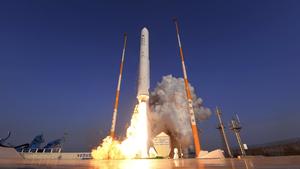 In this photo provided by Korea Aerospace Research Institute, a single stage rocket takes off from its launch pad at the Naro Space Center in Goheung, South Korea, Nov 28, 2018. (KOREA AEROSPACE RESEARCH INSTITUTE / AP)
In this photo provided by Korea Aerospace Research Institute, a single stage rocket takes off from its launch pad at the Naro Space Center in Goheung, South Korea, Nov 28, 2018. (KOREA AEROSPACE RESEARCH INSTITUTE / AP)
SEOUL - South Korea will be able to develop solid-fuel space launch vehicles under revised missile guidelines with the United States, Yonhap news agency reported Tuesday, citing the presidential Blue House.
Kim Hyun-chong, deputy director of the National Security Office (NSO) of the Blue House, told a press briefing that the missile guidelines were newly adopted as of Tuesday to completely lift the restrictions on the use of solid fuel for space launch vehicles
Kim Hyun-chong, deputy director of the National Security Office (NSO) of the Blue House, told a press briefing that the missile guidelines were newly adopted as of Tuesday to completely lift the restrictions on the use of solid fuel for space launch vehicles.
ALSO READ: 'S. Korea's missile explodes after unintentional launch'
The South Korea-US missile guidelines, first introduced in 1979 to restrict Seoul's ballistic missile development, are categorized into three parts, including the military ballistic missile, the military cruise missile and the space rocket.
It was the fourth revision, and the third was made in September 2017 to scrap the payload limit of 500 kg for South Korea's ballistic missiles with the range cap of 800 km.
ALSO READ: S. Korea test-launches 1st indigenous space rocket projectile
Under the fourth revision, all of South Korean companies, research institutes and even individuals will be allowed to develop, produce and possess various types of space launch vehicles using solid and hybrid fuels as well as liquid fuel without any restriction, Kim noted.
It would enable South Korea's military to launch homegrown low-earth-orbit reconnaissance satellites by the middle and late 2020s as planned to enhance the country's capability of intelligence and surveillance, he added.
READ MORE: S. Korea's PAC-2 interceptor explodes during training


